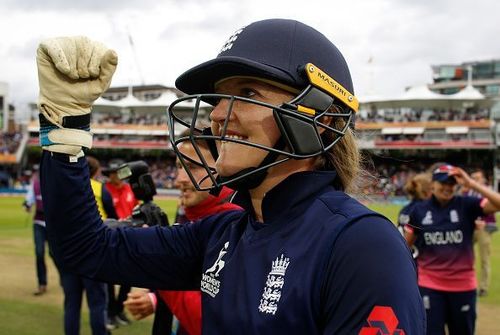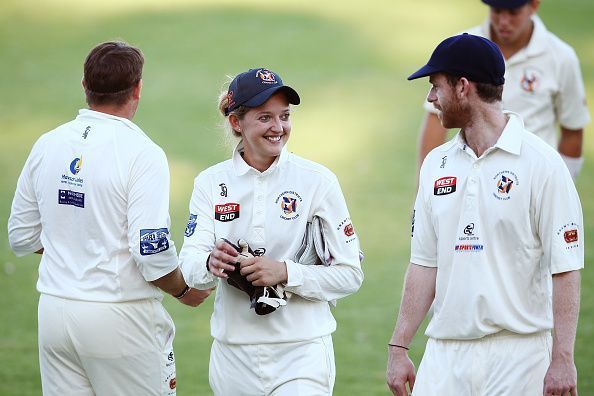
5 things to know about England wicketkeeper-batswoman Sarah Taylor

The ICC Women’s World Cup introduced us to 120 heroes from eight teams, all with inspiring stories.
Pakistan top order batter Javeria Khan was not allowed to play cricket with boys as their culture didn’t consider that morally right. India’s Punam Raut fought grave financial adversities to live her dreams, and if not for monetary help from her father’s boss, she would have never been able to buy her first cricket kit.
And then, there is England wicketkeeper-batter Sarah Taylor who fought mental illness to come back and deliver on a platform as big as the World Cup. Here are 5 things you should know about the 28-year-old.
#1 First Lady Cricketer to become part of ‘Legend’s Lane’
At the age of 26, Taylor was the first woman cricketer to become a part of the renowned ‘Legends Lane’ at The BrightonandHoveJobs.com County Ground, Hove. In case you didn’t know, the Legends Lane was formed to recognise the finest players to have represented Sussex in English domestic cricket. You will find images of greats like Tony Greig, CB Fry, John Snow, Matt Prior, and Mushtaq Ahmed at the arena. “The women’s game has transformed since I first joined Sussex in 2004. I’m only 26 so I am looking forward to continuing my career at the highest level for many years to come,” Taylor had said after being honoured.
#2 One of the youngest players from Brighton College to earn a national call-up
Brighton College in Sussex is one of the very few institutes that allows a game of cricket to be played between boys and girls. Taylor, a student of that college, along with Holly Colvin, became the youngest player to earn a national call-up, at the age of only 17. Sarah’s call-up shut the mouth of the then MCC President Robin Marlal, who had ridiculed the institute for letting both the genders play together.
She debuted for England against India at the iconic Lord’s Cricket Ground on August 14, 2006. However, it was only in the fourth ODI of the same series that she made her presence felt with a run-a-ball 61, and a few months later, scored her maiden century in Chennai against India. In the same series, she made her Test and T20 debuts as well, from where there was no looking back.
#3 Many feats at a young age

Until 2016, when she witnessed a slump in form, Sarah was a batting mainstay for England. In 2009, she became the fastest woman to amass 1000 ODI runs. In 2012, she was awarded the T20I Women’s Cricketer of the Year, an award which she claimed in 2013 as well. In 2014, she was named the ICC ODI Women’s Cricketer of the Year. In 2015, Taylor became the first woman cricketer to play men’s grade cricket.
Till date, she has played 110 ODIs in which she has scored 3657 runs at an average of 40.63. In Tests, she has amassed 266 runs from 8 innings at an average of 19. And in the shortest format, she has played 81 innings and scored 2054 runs at an average of 30.
#4 The major slump in 2016 – her battle with anxiety
After consistently producing the goods for years, it was in early 2016 when Taylor witnessed a slump in form. She could not muster more than 43 runs in the three-match ODI series against South Africa early that year. In the Women’s World T20 in India, she found herself struggling like never before as she scored only 49 runs in five games. In May that year, her decision to take an indefinite break from the sport shocked the world. She later revealed that she was struggling with major anxiety issues which affected her on-field performances.
"At its worst, it's a panic attack. On a cricket field, it happened mainly when I was about to bat, the expectation of wanting to score runs was the hardest. The nerves would hit me but it would be nerves plus something else. Obviously my cricket has been affected massively, but ultimately my personal life has been affected more. My day-to-day battles are huge,” she was quoted as saying on smh.com.au.
#5 The rebirth

For the first time since taking an indefinite break from cricket, Taylor joined the squad for a training camp in the United Arab Emirates in April this year, after which she was drafted into the World Cup squad, in which she proved that no mental disorder was bigger than one's determination to succeed.
“All of a sudden, I found myself wanting to train again, and it actually benefited my day-to-day learning and my anxiety. There’s still social anxiety; new places are still a struggle for me, and I still have to push through those on a day-to-day basis. I’m realistic that there will probably be some bumps. But if I get through it, I should look back and be completely proud of myself,” she told All Out Cricket.
In the World Cup, which her team won for the fourth time, Sarah scored 396 runs in nine innings.